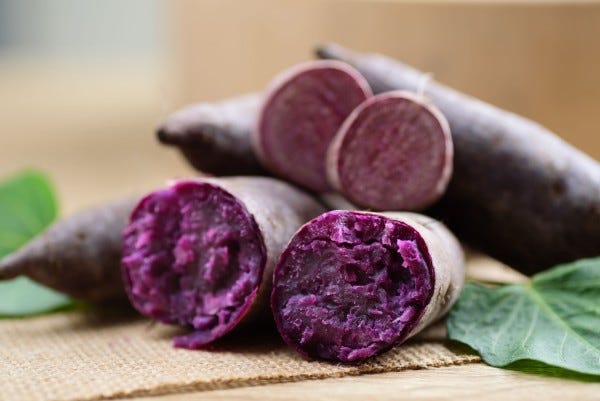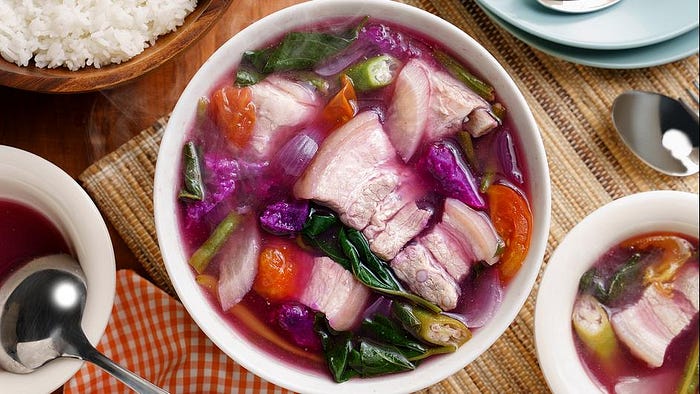I am an oddball when it comes to local delicacies. I find them too exotic despite their deep traditional roots. Even when traveling, I hardly go out of my way to find them.
In the Philippines where I am from, that is not a badge of honor.
Our country boasts a wide array of nick-knacks in rainbow colors, sticky or sweet, but not always nice. There is a rice cake dessert called suman I automatically desert. I am instantly diminished by the stench of durian that savoring its taste, which many find delicious, remains elusive. Strangest of all, I hardly find ube or purple yam enticing, even its ice cream form.
That is, until I mixed homemade halaya (ube jam) with sourdough, to discover for myself whether the Western world’s sudden hankering for it is a fad or the future of Filipino cuisine. The pairing worked, far beyond what I expected, so I decided to dive deeper into what makes it so.
HISTORY
Purple yam (or dioscorea alata), or ube in Tagalog, is a species of yam known for its bright violet color and mildly sweet, earthy taste. Similar yams include the sweet potato and taro, with which it is sometimes confused.

Archaeological evidence suggests that purple yam originated from Southeast Asia and New Guinea. Given its suitability for long travel, purple yam became a stable crop during the Austronesian expansion. This included a pit stop in the Philippines, where the crop was cultivated independently and where it continues to show the greatest tendency to vary (phenotypic variability). Over centuries, ube has evolved into an important crop in Southeast Asia, but more so in the Philippines, where it is a fast-growing native plant commonly used in traditional and modern desserts.
USES
The most common iteration of ube, at least locally, is the halaya, or ube jam. To make it, the purple yams are boiled until fork tender then mashed until smooth. It is then mixed with milk, sugar and margarine. The mixture is stirred consistently until it thickens and turns into a paste.
While it is enjoyed on its own, ube jam is the cherry on top of a local shaved ice dessert called halo-halo. And like other sweet jams such as strawberry, it pairs well with bread.
Purple yam is also turned into ube powder, which is a key ingredient in cakes and other baked goods. I have yet to use it, since ube grows so abundantly in these parts, but I can see how its powder form can further expand ube’s repertoire.
Although ube is more sweet than savory, it can be used as a substitute for its sister yams such as taro or sweet potato. I am excited to try using ube in sinigang — my favorite Filipino dish — to get not just a thicker broth but one with a lavender hue or turn it into chips for a healthier snack.

HEALTH BENEFITS
We are so used to ube as a dessert that its perceived caloric excess tends to overshadow its beneficial qualities.
Yams, in general, have significant nutritional value. It is a great source of potassium, dietary fiber, vitamin C and vitamin B6, which is essential for brain health.
Purple yam has all that plus anthocyanins, which have anti-inflammatory properties and can help protect the skin from sun damage. Anthocyanins are also what give the purple yam its vibrant color. This article highlights ube’s contributions to folk medicine, which uses it “to treat the symptoms of menopause, osteoporosis, rheumatoid arthritis, and infertility.” In traditional Chinese medicine, “diosgenin (the tuber storage protein of ube) is extracted from wild yam and used to treat kidney and liver problems.”
It just took the West a few centuries to discover what Filipinos and the rest of Southeast Asia have been enjoying for most of their lives. I am delighted that it finally caught on, and that ube has now found its place in the sun. That was rather surprising, but also enlightening, as growing appreciation for ube around the world has led me to my own path of discovery, which was also years in the making.
As a sourdough baker, I pay extra special attention to my ingredients. That is key to consistently creating good bread for a small but growing community, whose members include diabetics and cancer patients. The best way to help ensure their health is to use ingredients that arrive straight from the source.
However, the bread flour that I use comes from wheat that is only milled, not grown, in the Philippines. Wheat requires cold temperatures and cannot grow in the tropics. It cannot thrive in parts where ube can so the next best thing is to use the freshest flour I can find. But what if ube, like its fellow root crop — potato — is turned into flour? The outcome would be gluten-free, which can still yield bread. But can ube flour be economically viable for mass production? Maybe not right away, but it is possible, especially if local ube cultivation is strengthened with government support. It is something to consider in the wake of still ongoing tensions in the Ukraine — a major source of wheat.
Baking with ube has made the sourdough craft more meaningful for me because it is a gift from the ground I walk on. It is part of my history and baking bread with it allows me to pay tribute to my heritage.
That something is rooted in Philippine tradition is far from being just a fad. However, like many heirloom crops before it, ube is in danger of being colonized and displaced from the motherland. We Filipinos have a responsibility to protect and own it like the prized possession that it is. If the West with its disposable income is hungry for something that is native to the Philippines, it should fuel the Philippine economy, not the economies that manage to usurp the supply, plant the crop in their land, and make a killing from what is undeniably ours. Ube will only be here if those who love it will also fight for it.
In ube's honor, let us share our recipe for our best-selling ube queso sourdough loaf, so you may discover another way of savoring ube in your home kitchen. Enjoy!
UBE QUESO SOURDOUGH by Rise Artisanal
Total weight: around 1200g
Hydration: 78%
Yield: 1 loaf
25 grams wheat flour
25 grams bread flour
50 grams of water
Tip: Feed your starter the night before or at least 15 hours before bake prep, then feed it again 3 hours prior to the actual mixing. This ensures that you have an active starter that will help the bread achieve as much oven spring as possible.
For the bread:50 grams whole wheat flour (or any whole grain flour)
450 grams bread flour
10 g salt
390 g cold purified water
100g sourdough starter
75 g diced queso de bola
100g diced ube jam (halaya, preferably homemade)
4g ube flavoring (McCormick)
Instructions:
Mix dough
1. Place your starter into a bowl. Add the water. Mix for a bit before adding the flour.
2. Mix everything with your hands until no dry flour remains.
3. Leave the dough covered for 30 mins before adding the salt. Mix, do the first fold (see bulk fermentation below) then set aside covered for another 30 mins.
Prepare the add-ons
Dice queso de bola and ube jam. Place in the fridge.
Bulk fermentation
1. Over the next 1½ hours, you should stretch and fold the dough every 30 minutes. Three folds should do it (if you are baking in a tropical climate).
2. Just before the third and final set of stretch and folds, add the queso de bola, ube jam and ube flavoring. Mix well before folding.
3. Place dough unto a lightly floured surface. Add flour if the dough sticks to the surface too much.
4. Using a dough scraper, shape your loaf (see video). Do not skip this process.
5. Let the dough rest for 30 minutes, seam side up.
6. After the dough has rested, shape again. This time, you should see blisters forming on the surface of the dough.
7. Place in a floured banneton. Please use rice flour so the dough won’t stick to the banneton or to its lining if using.
8. Let it rest in the fridge overnight. For longer fermentation (which is great for gut health), strive for at least 12 hours of cold retarding before baking.
Bake
1. Preheat your Dutch oven/roasting pan/cookie sheet inside the oven at 230 C for an hour. You will need a very high temperature to bake the bread well.
2. In the meantime, place a parchment paper on top of your loaf then cover it with a plate. Turn it upside down.
2. Remove the banneton and prepare to score your bread.
3. Using a sharp blade or lame, score your bread by slicing through your loaf on the side or several times, depending on the scoring pattern of your choice.
4. Carefully place your scored bread into the Dutch oven, seal then return to the oven and bake it for 20 mins.
5. After baking for 20 mins, remove the cover of the Dutch oven then return your loaf inside the oven and bake for another 20 mins.
6. Remove the loaf from the oven and place on a cooling rack. Remove the parchment paper and set aside.
7. Let the loaf cool for an hour before slicing. The bread is still cooking at this time.
8. Slice and enjoy!

